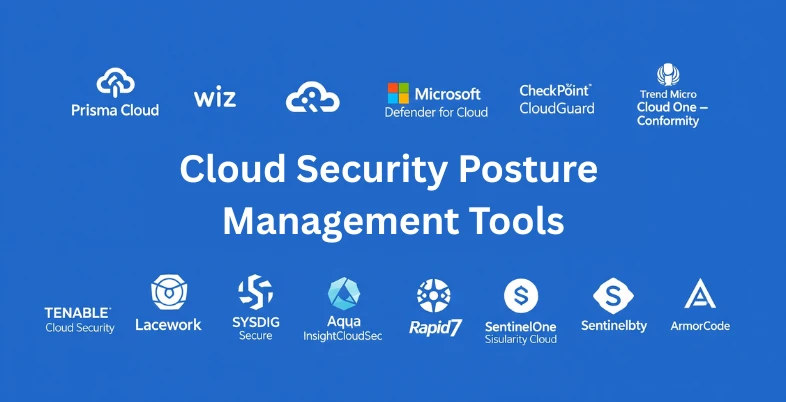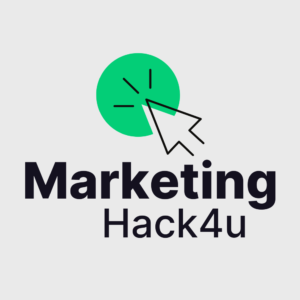Cloud Security Posture Management Tool (CSPM) involves a set of security tools and processes that continuously monitor and manage cloud infrastructure. Its purpose is to find misconfigurations, ensure compliance, and lower risk. As businesses increasingly adopt cloud-native architectures and work on platforms like AWS, Azure, and GCP, keeping configurations correct and security practices strong becomes more challenging. CSPM solutions tackle this by providing automated visibility, detection, and fixing of vulnerabilities related to cloud misconfigurations, identity privileges, and policy drift.
CSPM tools focus on a proactive, configuration-based approach. They do not aim to detect malware or stop attacks in real-time. Instead, they work to prevent the weaknesses that make such attacks possible. By continuously reviewing cloud environments against set security standards or compliance frameworks, CSPM helps organizations strengthen their infrastructure and decrease the chances of breaches caused by poorly managed assets.
What are Cloud Security Posture Management Tools
Cloud Security Posture Management (CSPM) tools are cybersecurity solutions designed to continuously monitor, assess, and improve the security posture of cloud environments. These tools help organizations identify misconfigurations, ensure compliance, and reduce risks in public, private, or hybrid cloud infrastructures.
Why CSPM Matters in Modern Cloud Environments
Cloud platforms provide unmatched scalability and flexibility, but they create a new set of risks. These include issues related to APIs, mismanaged identities, exposed storage, loose security groups, and untagged resources. CSPM is essential for three main reasons:
Misconfigurations are the top cause of cloud breaches. Open S3 buckets or overlooked IAM roles with admin rights serve as easy targets for attackers.
Cloud environments change constantly. With instances being created or removed, developers deploying via CI/CD pipelines, and infrastructure defined as code, risks can be introduced quickly.
Audits done by hand are unable to keep up. Modern cloud configurations are too large and complex for human-driven audits. This procedure is automated by CSPM for large-scale, ongoing management.
According to Gartner, client configuration errors will account for more than 90% of cloud security incidents by 2026. Because of this, CSPM is an essential component of any cloud security strategy.
How CSPM Works: Main Components
CSPM solutions scan cloud environments nonstop and compare them to known best practices, compliance standards, or user-defined policies. Most platforms do not use agents and instead depend on cloud-native APIs for visibility. Here’s how a typical CSPM workflow operates:
1. Asset Discovery
CSPM first discovers all cloud resources, including virtual machines, storage buckets, IAM roles, security groups, databases, load balancers, and Kubernetes clusters across accounts and regions. This inventory serves as the foundation for all future security assessments.
2. Configuration Assessment
Next, it assesses whether these resources are configured securely. For example, it may identify an unencrypted RDS instance, an internet-exposed VM, or a public storage bucket. Each misconfiguration is highlighted with severity and context.
3. Policy Mapping
CSPM tools connect identified misconfigurations to security policies such as CIS Benchmarks, NIST 800-53, PCI DSS, HIPAA, and SOC 2. This ensures regulatory compliance and security alignment.
4. Remediation Recommendations
Based on the issues found, CSPM tools provide automatic or guided remediation advice. Some platforms integrate directly with Infrastructure as Code (IaC) systems to correct vulnerabilities before deployment.
5. Continuous Monitoring
CSPM tools operate at all times, not just during audits. This guarantees that any changes from secure configuration standards are detected almost in real-time.
List of Top 15 Cloud Security Posture Management (CSPM) Tools
1. Palo Alto Networks Prisma Cloud
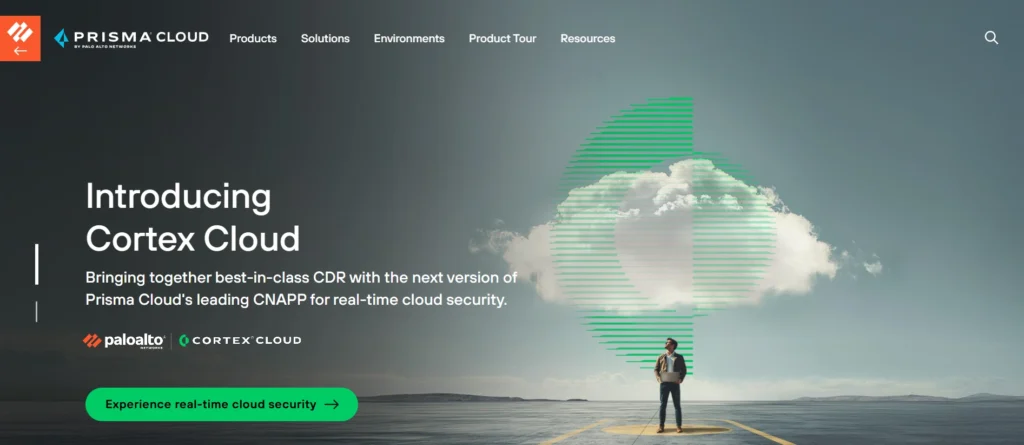
Prisma Cloud, created by Palo Alto Networks, is a complete cloud-native application protection platform that features a strong CSPM module. Many large enterprises and global organizations trust it for its extensive visibility across AWS, Azure, GCP, and Oracle Cloud environments. Prisma Cloud constantly scans cloud accounts to find misconfigurations, deviations from baseline setups, and security issues in real time. It includes over 2,000 built-in policies and templates that align with common frameworks like CIS, NIST, PCI-DSS, and GDPR.
Prisma Cloud goes beyond basic configuration checks by integrating workload protection for containers, hosts, and serverless functions. It supports Infrastructure as Code (IaC) scanning, fits into CI/CD pipelines, and offers unified policy management across cloud layers. This makes it highly effective for DevSecOps and compliance teams in regulated environments.
Features:
- Multi-cloud security monitoring (AWS, Azure, GCP, OCI)
- Policy-as-code and auto-remediation
- Deep compliance coverage (HIPAA, ISO 27001, CIS, etc.)
- IaC scanning and CI/CD integration
- Unified dashboards for cloud risk posture
Pricing:
- Custom enterprise pricing based on resource count and cloud services.
2. Wiz
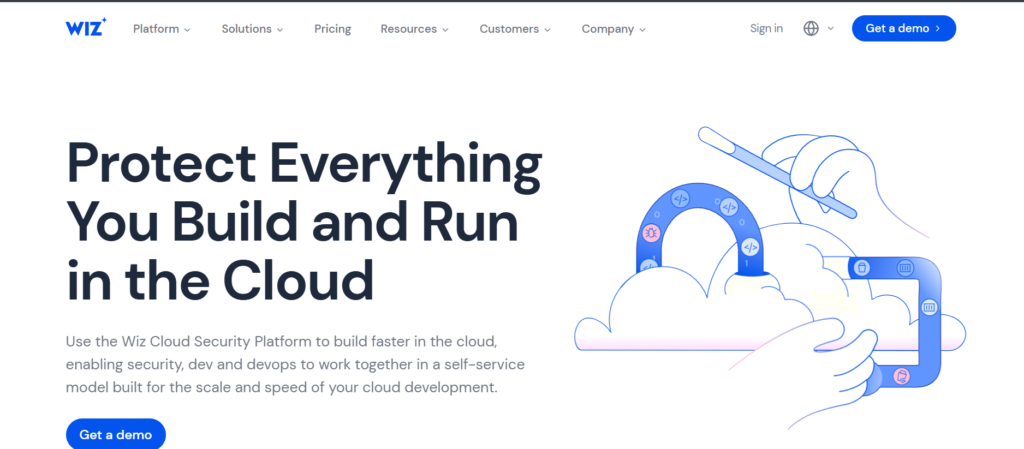
Wiz is an agentless, high-context CSPM platform that has quickly gained popularity among large enterprises and security-focused startups. The platform provides extensive cloud visibility and threat detection without needing agents or network taps. Its main strength is the “Security Graph,” a unique risk visualization layer that links misconfigurations, public exposure, lateral movement paths, and identity risks across cloud environments.
Wiz supports all major cloud platforms, such as AWS, Azure, GCP, and OCI. It scans compute workloads, containers, Kubernetes clusters, and serverless functions. It also conducts vulnerability scans, secret detection, and exposure analysis, all without impacting performance. Wiz is especially appreciated for prioritizing risks by attack paths and delivering quick results with minimal deployment effort.
Features:
- Agentless architecture with full-stack scanning
- Security Graph for contextual attack path mapping
- Identity and permissions analysis
- Policy enforcement and remediation guidance
- API-first integration for DevOps pipelines
Pricing:
- Custom pricing based on cloud size and number of workloads.
3. Microsoft Defender for Cloud
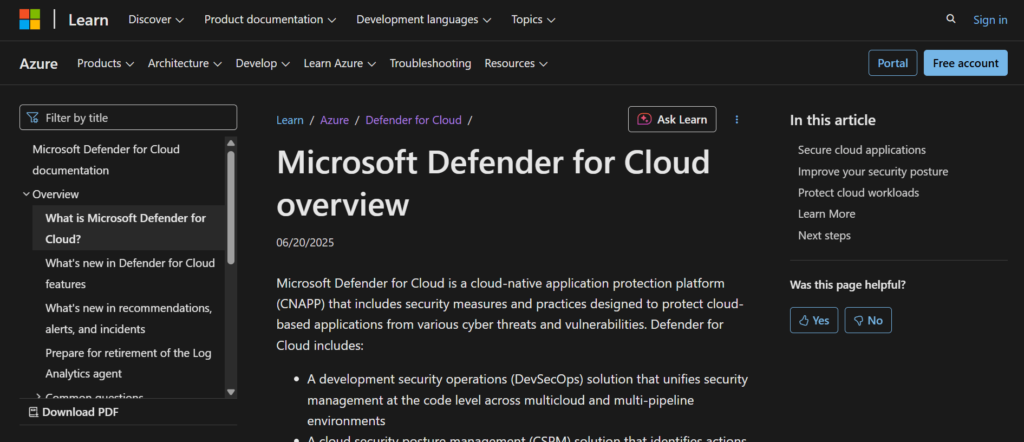
Microsoft Defender for Cloud, a native CSPM and workload protection platform for Azure. It is beneficial for organizations already within the Microsoft ecosystem, providing smooth integrations with Azure Active Directory, Microsoft Sentinel, and Microsoft 365 Defender.
Defender for Cloud offers continuous assessments of cloud posture through a Secure Score, a metric that helps users prioritize remediation tasks. The platform allows for automated remediation using Azure Policy, evaluates role-based access control, and detects threats in real time. It also aligns security configurations with industry frameworks such as CIS, NIST, and PCI-DSS.
Features:
- Secure Score benchmarking for posture analysis
- Continuous compliance checks for Azure, AWS, GCP
- Threat detection and VM Just-in-Time access control
- Native integration with Microsoft tools and SIEMs
- Regulatory compliance management dashboards
Pricing:
- Starts at $15 per resource/month for CSPM functionality.
4. Check Point CloudGuard
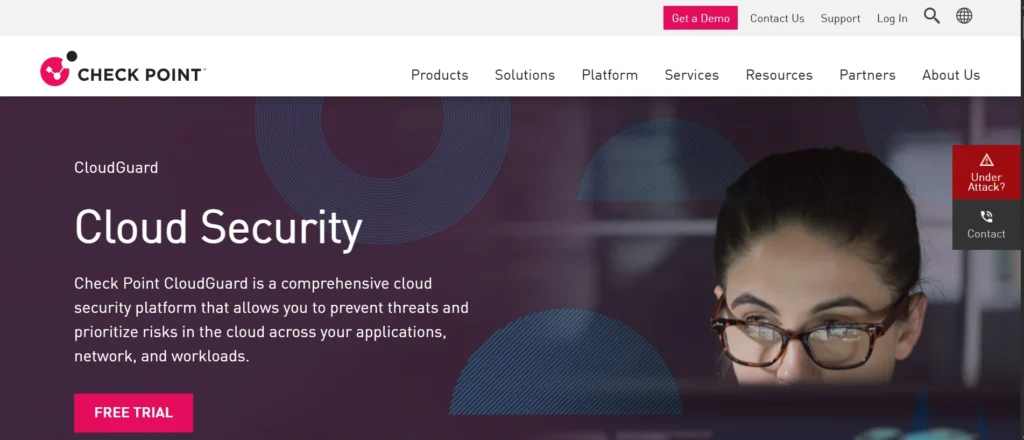
CloudGuard by Check Point provides strong CSPM capabilities, with a focus on real-time visibility, policy enforcement, and threat prevention. It supports multi-cloud environments, allowing users to monitor configuration drift, IAM mismanagement, and unauthorized changes through automated rules and integrations.
A notable feature of CloudGuard is its visualization engine, which illustrates cloud architectures and network flows. This helps users identify exposure paths or shadow assets. The platform supports both manual and automatic remediation workflows and integrates well with DevOps toolchains and ticketing systems.
Features:
- Posture management and real-time cloud asset discovery
- Policy enforcement and misconfiguration detection
- Identity and access risk mapping
- Compliance tracking for SOC 2, ISO, and PCI
- Visual topology maps of cloud infrastructure
Pricing:
- Custom enterprise pricing available upon request.
5. Trend Micro Cloud One – Conformity
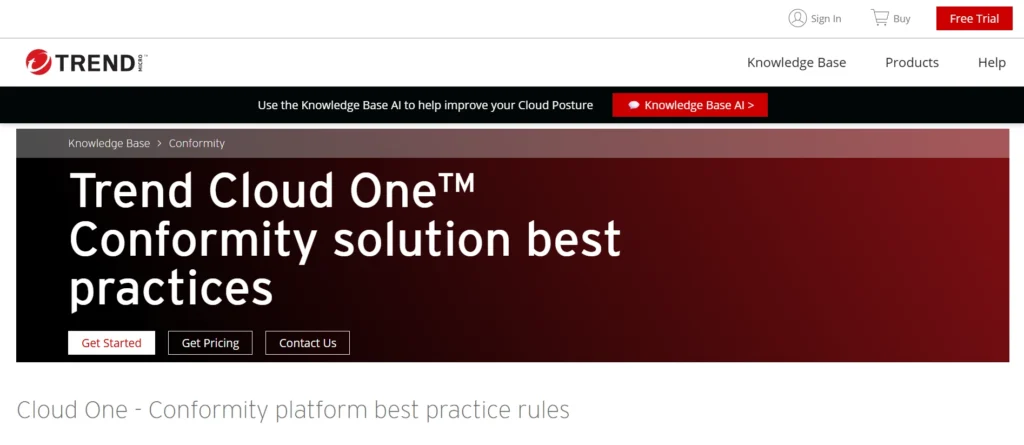
Trend Micro Conformity, part of the Cloud One platform, offers a lightweight yet effective CSPM tool aimed at small to mid-size businesses and cloud-native teams. It supports Google Cloud and Azure and performs well in AWS setups.
Conformity continuously evaluates infrastructure against over 750 built-in best practices and compliance checks. To notify engineering teams of misconfigurations, it interfaces with Slack, Jira, and ServiceNow. Its simple user interface and clear policy recommendations make it appealing for teams without a dedicated security operations center.
Features:
- Over 750 built-in security and compliance checks
- Alerts for misconfigurations, IAM drift, and exposed services
- Supports integrations with DevOps tools and messaging apps
- Real-time compliance reporting for PCI, ISO, HIPAA, etc.
- Easy policy customization and implementation
Pricing:
- Starts at $7 per month per cloud account, with scalable plans available.
Also Read: Antivirus For Android
6. Lacework
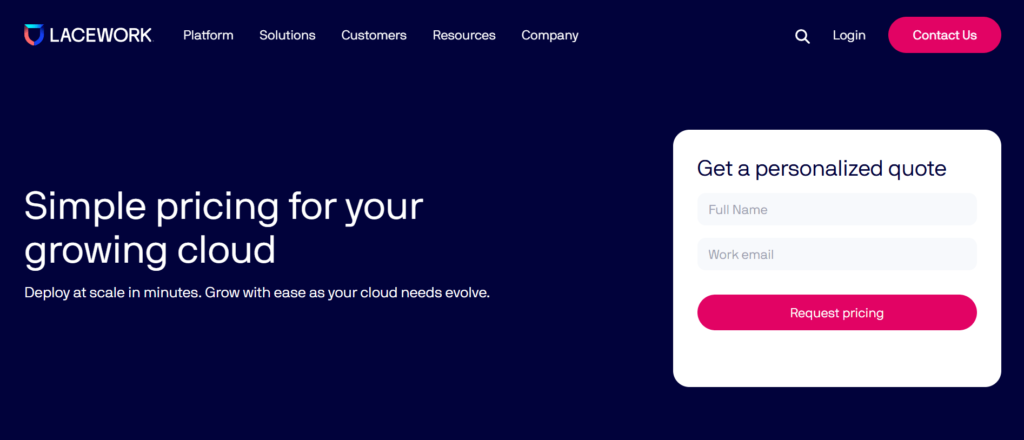
Lacework is a modern cloud-native application security platform that merges CSPM with advanced workload protection and behavioral analytics. It stands out with its anomaly-based threat detection engine, which uses machine learning to assess baseline behaviors across cloud accounts, workloads, and Kubernetes clusters. This allows Lacework to effectively identify unknown or evolving threats that traditional rule-based systems may overlook.
As a CSPM tool, Lacework continuously audits configurations across AWS, Azure, and Google Cloud. It prioritizes risks based on contextual severity and exploitability. It also supports Infrastructure as Code (IaC) scanning, which helps teams find misconfigurations before deployment. Integration with CI/CD pipelines and DevOps toolchains enables secure development without delaying deployment cycles. Lacework’s centralized dashboard gathers alerts and recommendations across multi-cloud environments, making incident response and compliance reporting easier.
Features:
- Behavior-based anomaly detection with ML models
- Continuous posture monitoring across AWS, GCP, and Azure
- IaC scanning and developer-focused remediation advice
- Compliance tracking for PCI-DSS, SOC 2, HIPAA
- Unified dashboard for threat and configuration visibility
Pricing:
- Custom pricing based on resource usage and scale.
7. Tenable Cloud Security (formerly Ermetic)
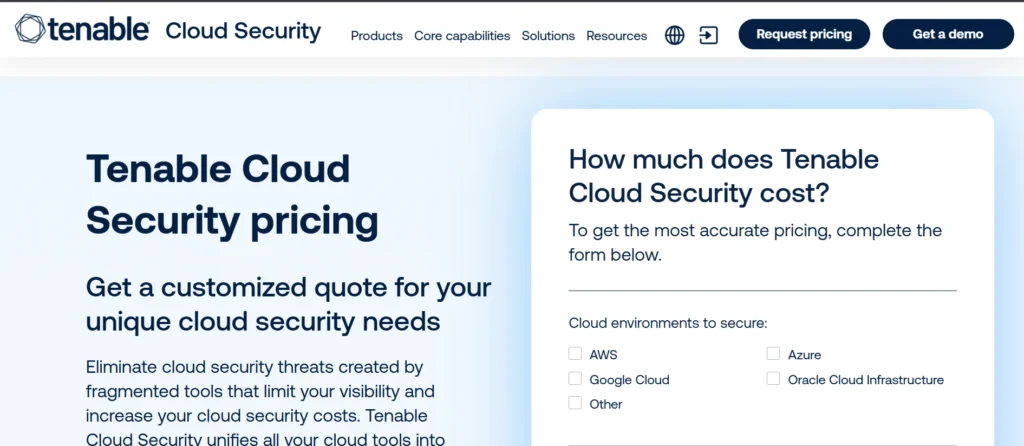
Tenable Cloud Security offers strong identity-focused CSPM capabilities that help uncover hidden risks in permissions, misconfigurations, and network exposure across AWS, Azure, and Google Cloud. Originally developed by Ermetic and later acquired by Tenable, the tool specializes in analyzing excessive permissions and attack paths from mismanaged IAM roles.
The platform visualizes cloud identities, roles, and policies in an interactive graph. This helps security teams understand and enforce least-privilege access. Tenable Cloud Security also includes automated remediation options, real-time policy violations, and asset discovery across multi-cloud setups. Its focus on IAM governance makes it a great choice for organizations facing complex access control challenges.
Features:
- Identity-centric risk mapping and permission analysis
- Attack path visualization and remediation planning
- Policy evaluation for compliance and least privilege
- Auto-remediation of over-permissioned roles
- Integration with SIEM and DevOps tools
Pricing:
- Available upon request with flexible enterprise plans.
8. Sysdig Secure
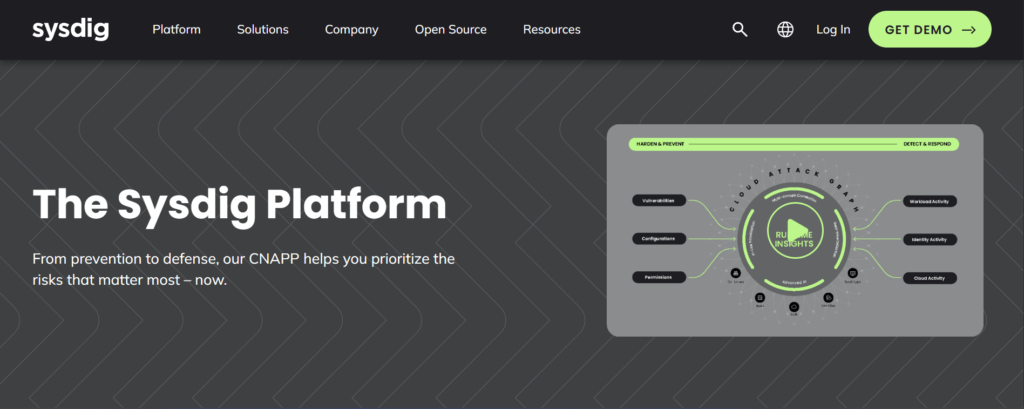
Sysdig Secure offers a mix of container runtime security and CSPM features, specifically for organizations using Kubernetes-based environments. Initially designed for monitoring and securing container workloads, Sysdig has developed into a comprehensive CNAPP platform that includes CSPM functionality.
Its CSPM capabilities cover AWS, Azure, and GCP. It provides continuous scanning for misconfigurations, network exposure, and compliance violations. Sysdig’s runtime security engine links cloud configuration risks to live production environments. This helps teams see which misconfigurations are actually exploitable, making risk prioritization more actionable. Sysdig also offers detailed Kubernetes auditing, assisting in securing complex microservices deployments.
Features:
- CSPM with real-time container and Kubernetes threat detection
- Cloud configuration analysis with runtime insights
- Compliance auditing for SOC 2, HIPAA, PCI
- CI/CD integration and IaC scanning
- Threat correlation between posture and active risks
Pricing:
- Starts at $20 per node/month, with volume-based discounts.
9. Aqua Security (Aqua Trivy & Aqua Platform)
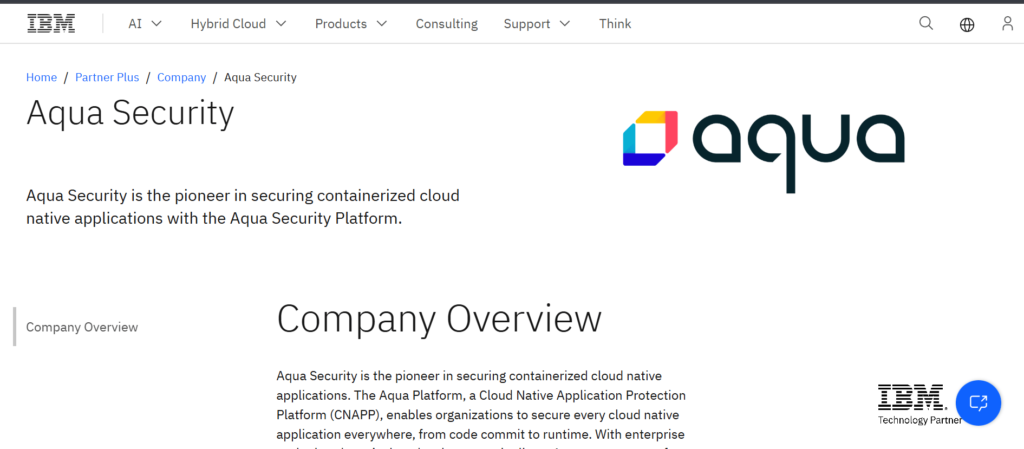
Aqua Security’s CSPM features are part of its larger cloud-native security suite, which includes Aqua Trivy, an open-source scanner, and the Aqua Platform. Aqua provides full CSPM capabilities for multi-cloud environments, focusing on risk detection, posture enforcement, and compliance automation.
Trivy scans cloud configuration files and container images for misconfigurations. The commercial Aqua Platform offers centralized visibility into security posture across workloads and infrastructure. It connects misconfigurations to compliance requirements and suggests prioritized remediation actions, making it suitable for teams seeking strong governance across DevSecOps pipelines.
Features:
- Scanning of IaC, container images, and cloud assets
- Policy enforcement linked to CIS, PCI, NIST frameworks
- Risk-aware prioritization of misconfigurations
- Integration with CI/CD pipelines and GitOps tools
- Extensive Kubernetes and microservices visibility
Pricing:
- Trivy is free and open-source; Aqua Platform offers enterprise pricing upon request.
10. Rapid7 InsightCloudSec
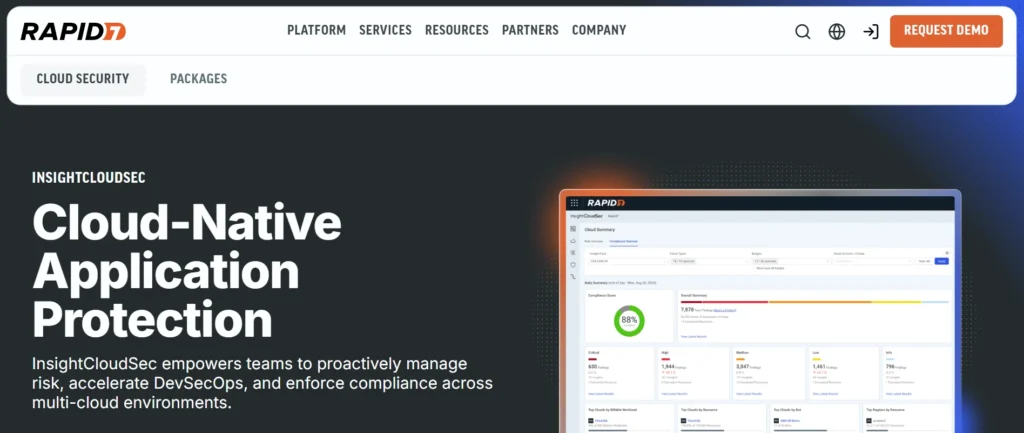
InsightCloudSec, acquired by Rapid7, is a combined cloud security platform that merges CSPM, CIEM, and threat detection into one solution. Its real-time inventory and compliance engine scans all major cloud platforms for misconfigurations, policy violations, and risks linked to exposed services or permissions.
InsightCloudSec excels in automation, offering automated remediation, compliance drift correction, and governance-as-code tools. It integrates with ticketing systems and SIEMs to simplify incident management. The platform also provides detailed breakdowns of IAM privileges and combines resource visibility with threat analytics, making it a preferred choice for teams dealing with complex cloud environments.
Features:
- Unified CSPM + CIEM + threat detection
- Real-time configuration scanning across AWS, Azure, GCP
- Automated remediation and governance-as-code
- IAM visibility and least-privilege enforcement
- Support for SOC 2, HIPAA, PCI, GDPR compliance
Pricing:
- Custom pricing based on the size of the cloud environment and feature usage.
11. Orca Security
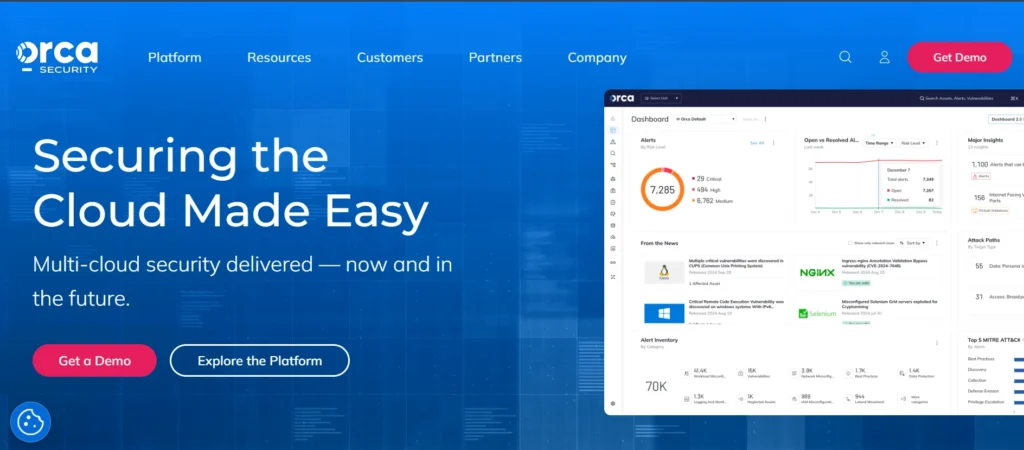
Orca Security delivers agentless, comprehensive Cloud Workload Protection by scanning cloud environments from the inside out. Its SideScanning™ technology collects data directly from the cloud provider’s APIs and workloads without requiring agents or network taps. This unique approach allows for complete visibility into virtual machines, containers, serverless functions, and Kubernetes clusters.
Orca also provides context-aware risk prioritization by correlating vulnerabilities, misconfigurations, and identity risks. It excels in helping security teams focus on the most impactful threats by mapping them to the business context and attack paths. Orca’s ease of deployment and deep visibility make it a popular choice for large-scale multi-cloud environments.
Key Features:
- Agentless workload scanning via patented SideScanning™
- Context-aware risk prioritization and attack path analysis
- Support for AWS, Azure, GCP, and Kubernetes
- Deep visibility into vulnerabilities, malware, and misconfigurations
- Fast onboarding without performance impact
Pricing:
- Custom pricing based on cloud footprint and number of assets.
Also Read: Cyber Security Companies in India
12. Snyk Cloud
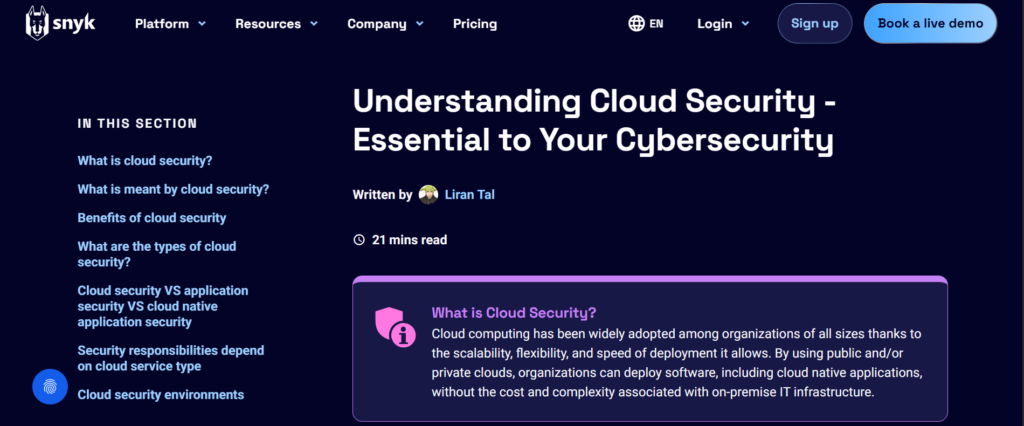
Snyk Cloud is a developer-first Cloud Workload Protection Platform built to secure the full cloud-native application lifecycle—from code to cloud. Originally known for its strength in code and dependency scanning, Snyk has expanded into CWPP through its acquisition of Fugue. Snyk Cloud now offers infrastructure as code (IaC) scanning, cloud configuration analysis, and runtime protection.
Its unified policy engine ensures that security and compliance policies are enforced consistently across environments. What makes Snyk Cloud particularly valuable is its tight integration with CI/CD pipelines, making it a favorite among DevSecOps teams looking to shift security left. It supports multi-cloud environments and helps teams remediate vulnerabilities before they reach production.
Key Features:
- Policy-as-code enforcement for IaC and runtime
- Real-time detection of misconfigurations and drift
- Deep integration with CI/CD pipelines and developer tools
- Cloud resource inventory with compliance mapping
- Support for AWS, Azure, and GCP
Pricing:
- Custom pricing; starts with a free tier for limited projects, then scales by usage and team size.
13. SentinelOne Singularity Cloud
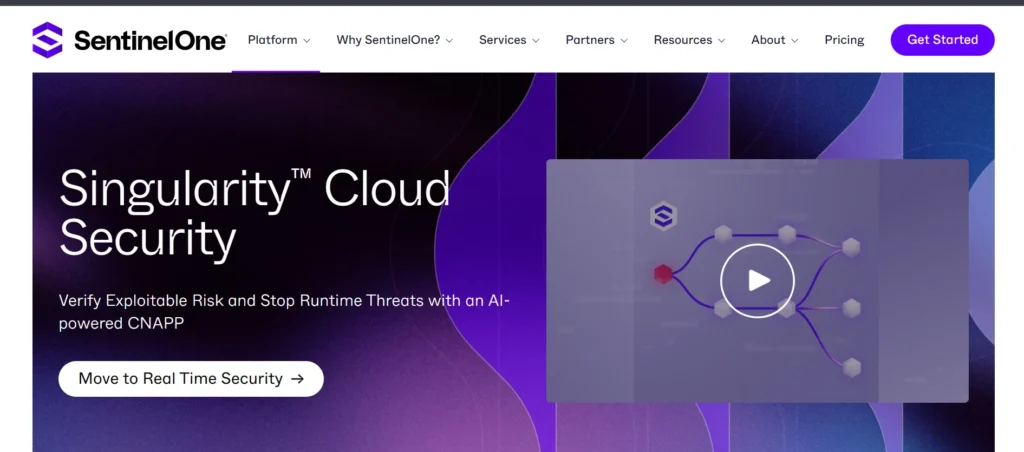
SentinelOne’s Singularity Cloud platform includes CSPM as part of a wider strategy for cloud protection that combines workload protection, container security, and posture management. Designed with an AI-first approach, the platform identifies cloud misconfigurations and integrates that data with real-time behavioral analytics and threat detection.
Its CSPM module scans AWS, Azure, and GCP environments for policy violations, IAM problems, and risky services. Singularity Cloud correlates posture misconfigurations with runtime security data, helping prioritize the most critical risks. It offers visibility for containers and serverless infrastructure, making it suitable for security-focused organizations that operate at scale. Singularity’s single-agent architecture and automated response features ease the workload on security teams.
Features:
- Unified CSPM and runtime threat analytics
- AI-driven risk prioritization
- Integration with EDR/XDR for full cloud-to-endpoint coverage
- Analysis of identity, workload, and network misconfigurations
- Support for serverless environments and containers
Pricing:
- Available upon request; pricing varies based on deployment size and services.
14. Fortinet FortiCNP
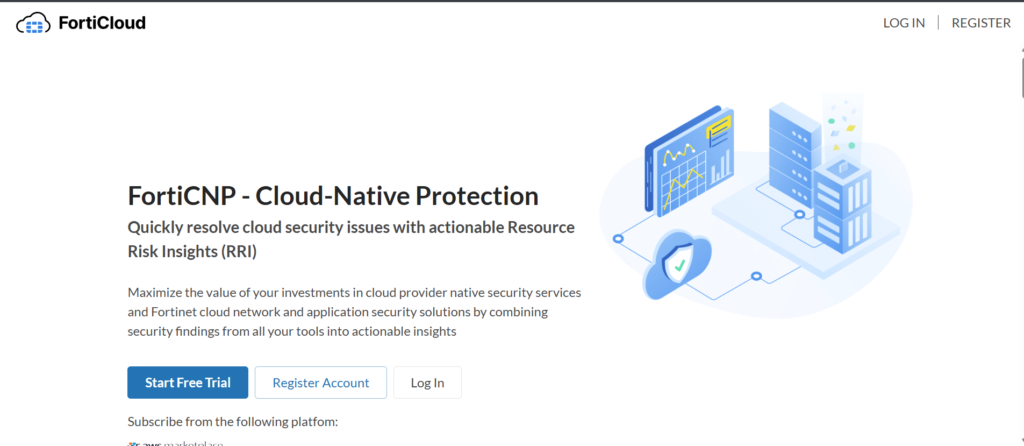
Fortinet FortiCNP (Cloud-Native Protection) is Fortinet’s specialized CWPP solution designed for cloud-first organizations using AWS, Azure, or GCP. It provides deep integration with native cloud services to monitor, prioritize, and remediate security risks across workloads and infrastructure. FortiCNP stands out for its use of Resource Risk Insights (RRI), which filter out noise and highlight the most relevant security issues based on context.
The platform leverages Fortinet’s vast threat intelligence via FortiGuard Labs and integrates seamlessly with Fortinet’s broader Security Fabric, including FortiGate firewalls and FortiAnalyzer. Its agentless architecture simplifies deployment while maintaining high levels of detection accuracy and contextual awareness.
Key Features:
- Resource Risk Insights (RRI) for contextual risk prioritization
- Agentless scanning of cloud-native resources
- Integration with AWS Security Hub, Azure Security Center, and GCP SCC
- Real-time threat intelligence from FortiGuard
- Policy-based automation and alerting
Pricing:
- Custom pricing; varies by cloud environment and scope of integration.
15. ArmorCode
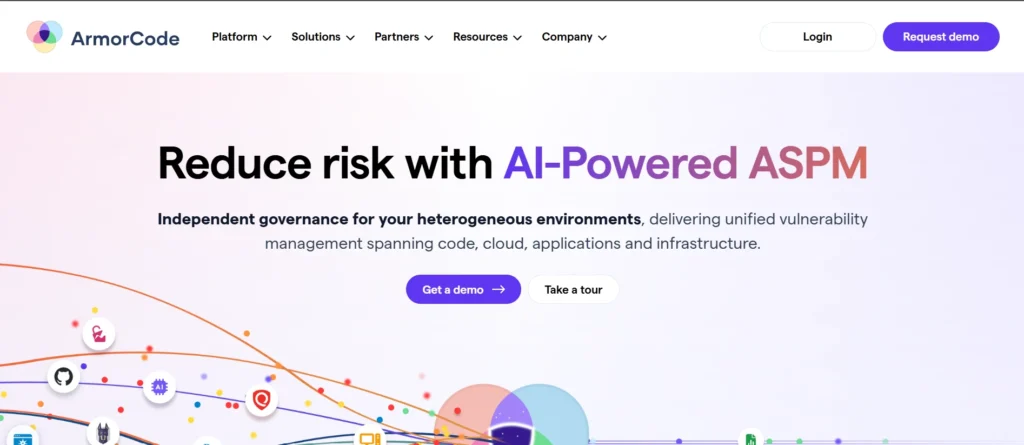
ArmorCode is a quickly growing security platform that includes CSPM as part of its Application Security Posture Management (ASPM) offering. While it may not be as established as older vendors, it stands out by unifying vulnerability management, misconfiguration detection, and DevSecOps orchestration in one console. ArmorCode supports multiple public cloud platforms and integrates with tools like Terraform, GitHub, Jenkins, and Jira for security orchestration and continuous posture checks.
Its CSPM features include real-time detection of misconfigured resources, paths for privilege escalation, open ports, and untagged cloud assets. ArmorCode also enables auto-remediation based on pre-set security rules, ensuring that any deviation from secure standards is quickly corrected. Teams can define specific policies that trigger alerts or corrective actions when high-risk configurations arise, making it a solid option for fast-paced development teams.
Features:
- CSPM with CI/CD security orchestration
- Misconfiguration and cloud asset visibility
- IaC and API security scanning
- Integration with GitOps and ticketing tools
- Real-time posture alerts and auto-remediation
Pricing:
- Available upon request; free trial for small teams offered.
Common Challenges in CSPM Implementation
Despite its advantages, CSPM adoption can face several challenges:
- Alert fatigue: Without proper settings, CSPM tools may overwhelm teams with many non-critical alerts. It’s essential to prioritize based on context and exploitability.
- Multi-cloud complexity: Managing posture across AWS, Azure, and GCP can create fragmented tools and policies. It’s better to use tools with unified dashboards and policy management.
- Lack of context: CSPM may flag a problem without providing insights into actual risk. For instance, a public IP is only a threat if linked to sensitive workloads.
- Remediation gaps: While automated remediation is valuable, it can cause disruptions if not managed properly. Role-based access and change controls need careful implementation.
Conclusion
CSPM is no longer optional. It is a vital part of cloud-native security structures. By offering visibility into misconfigurations, compliance issues, and security weaknesses, CSPM platforms help organizations reduce risk before it can lead to an exploit. Whether working with a single cloud provider or managing multiple clouds, integrating CSPM into your DevSecOps pipeline is crucial for secure and sustainable cloud operations.
The landscape will keep evolving, but the core value of CSPM remains the same: prevention through visibility and configuration control. In an era where the cloud never sleeps, security posture must remain vigilant as well.
FAQs
1. What’s the difference between CSPM and CWPP?
CSPM aids in finding and fixing cloud misconfigurations, while CWPP (Cloud Workload Protection Platforms) safeguards active workloads, like VMs and containers, from runtime threats. CSPM is proactive, while CWPP is protective.
2. Does CSPM replace cloud provider security tools?
No. Though AWS, Azure, and GCP offer built-in security features, CSPM platforms provide a unified view across multiple cloud environments and work with third-party tools to improve posture management.
3. Can CSPM prevent breaches?
Yes. By identifying and fixing misconfigurations, CSPM helps avert common cloud breaches caused by human mistakes or insecure defaults.
4. Is CSPM only useful for large enterprises?
No. CSPM benefits businesses of all sizes. Small startups using cloud infrastructure can also face risks from misconfigurations, and lighter CSPM tools are available for smaller teams.
5. Do I need a CSPM if I use Infrastructure as Code?
Absolutely. CSPM tools that check IaC templates are essential for finding configuration issues before they go live.
